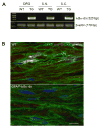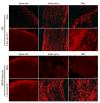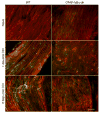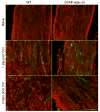Transgenic inhibition of glial NF-kappa B reduces pain behavior and inflammation after peripheral nerve injury
- PMID: 20097004
- PMCID: PMC2853034
- DOI: 10.1016/j.pain.2010.01.001
Transgenic inhibition of glial NF-kappa B reduces pain behavior and inflammation after peripheral nerve injury
Abstract
The transcription factor nuclear factor kappa B (NF-kappaB) is a key regulator of inflammatory processes in reactive glial cells. We utilized a transgenic mouse model (GFAP-IkappaBalpha-dn) where the classical NF-kappaB pathway is inactivated by overexpression of a dominant negative (dn) form of the inhibitor of kappa B (IkappaBalpha) in glial fibrillary acidic protein (GFAP)-expressing cells, which include astrocytes, Schwann cells, and satellite cells of the dorsal root ganglion (DRG) and sought to determine whether glial NF-kappaB inhibition leads to a reduction in pain behavior and inflammation following chronic constriction injury (CCI) of the sciatic nerve. As expected, following CCI nuclear translocation, and hence activation, of NF-kappaB was detected only in the sciatic nerve of wild type (WT) mice, and not in GFAP-IkappaBalpha-dn mice, while upregulation of GFAP was observed in the sciatic nerve and DRGs of both WT and GFAP-IkappaBalpha-dn mice, indicative of glial activation. Following CCI, mechanical and thermal hyperalgesia were reduced in GFAP-IkappaBalpha-dn mice compared to those in WT, as well as gene and protein expression of CCL2, CCR2 and CXCL10 in the sciatic nerve. Additionally, gene expression of TNF, CCL2, and CCR2 was reduced in the DRGs of transgenic mice compared to those of WT after CCI. We can therefore conclude that transgenic inhibition of NF-kappaB in GFAP-expressing glial cells attenuated pain and inflammation after peripheral nerve injury. These findings suggest that targeting the inflammatory response in Schwann cells and satellite cells may be important in treating neuropathic pain.
Conflict of interest statement
Figures









References
-
- Bennett GJ, Xie YK. A peripheral mononeuropathy in rat produces disorders of pain sensation like those seen in man. Pain. 1988;33:87–107. - PubMed
-
- Campana WM, Li X, Shubayev VI, Angert M, Cai K, Myers RR. Erythropoietin reduces Schwann cell TNF-α, Wallerian degeneration and pain-related behaviors after peripheral nerve injury. Eur J Neurosci. 2006;23:617–26. - PubMed
Publication types
MeSH terms
Substances
Grants and funding
LinkOut - more resources
Full Text Sources
Research Materials
Miscellaneous

